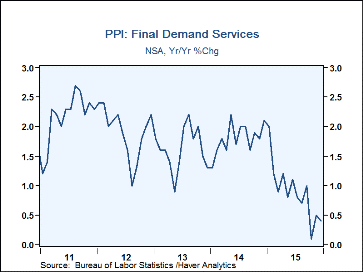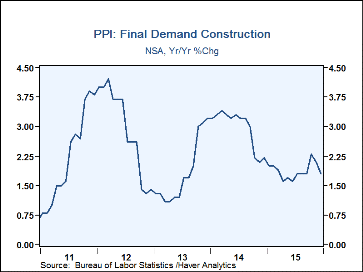 Global| Jan 15 2016
Global| Jan 15 2016U.S. Producer Prices Slip in December on Goods
by:Sandy Batten
|in:Economy in Brief
Summary
The headline Final Demand Producer Price Index fell 0.2% m/m (-1.0% y/y) in December after having jumped 0.3% m/m in November. This was the fourth monthly decline in the past five months. The Action Economics Forecast Survey had [...]
The headline Final Demand Producer Price Index fell 0.2% m/m (-1.0% y/y) in December after having jumped 0.3% m/m in November. This was the fourth monthly decline in the past five months. The Action Economics Forecast Survey had looked for a 0.2% m/m decrease. For all of 2015, final demand producer prices fell 1.0% after rising 0.9% in all of 2014. Final demand producer prices excluding the volatile food and energy components edged up 0.1% m/m (0.3% y/y) in December, also in line with the forecast survey, on top of a 0.3% m/m increase in November.
The monthly decline in December was due to a 0.7% m/m drop in final demand goods prices. This was the sixth consecutive monthly decline in final demand goods prices. Compared to a year earlier, final demand goods prices were down 3.7%. Prices of final demand services inched up 0.1% m/m. This was the second consecutive monthly increase in final demand services prices, which were up 0.4% from a year ago.
More than three quarters of the December fall in final demand goods prices can be traced to energy, which fell 3.4% m/m (-16.2% y/y), with gasoline prices falling 8.3% (-29.1% y/y). Prices of final demand foods decreased 1.3% m/m (-5.2% y/y). Conversely, prices of pharmaceutical preparations jumped up 1.1% m/m (8.2% y/y).
The December rise in final goods services prices was due largely to a 0.4% m/m increase (1.0% y/y) in services prices less trade, transportation, and warehousing. The index of final demand trade services continued to exhibit its marked monthly volatility, falling 0.4% m/m in December, following a 1.2% m/m rise in November and a 0.7% m/m drop in October. This category represents estimates of margins charged by retail and wholesale dealers; its monthly volatility has been difficult to interpret and been a key source of volatility in the overall final demand index.
The final demand services PPI for medical care rose 0.4% m/m in December, reflecting a 1.3% m/m jump in prices of physician services and a 0.2% m/m increase in prices of hospital services. These prices are key components in constructing the PCE price deflator (headline and core) and so will likely give that price measure a meaningful boost in December.
Final demand construction prices were unchanged in December from November to be up 1.8% from a year earlier.
The PPI data are contained in Haver's USECON database with further detail in PPI and PPIR. The expectations figures are available in the AS1REPNA database.
| Producer Price Index (SA, %) | Dec | Nov | Oct | Dec Y/Y | 2015 | 2014 | 2013 |
|---|---|---|---|---|---|---|---|
| Final Demand | -0.2 | 0.3 | -0.4 | -1.0 | -0.9 | 1.6 | 1.4 |
| Excluding Food & Energy | 0.1 | 0.3 | -0.3 | 0.3 | 0.8 | 1.7 | 1.5 |
| Goods | -0.7 | -0.1 | -0.4 | -3.7 | -4.3 | 1.2 | 0.9 |
| Foods | -1.3 | 0.3 | -0.8 | -5.2 | -2.6 | 3.1 | 1.7 |
| Energy | -3.4 | -0.6 | 0.0 | -16.2 | -20.6 | -1.0 | -0.8 |
| Goods Excluding Food & Energy | 0.1 | -0.1 | -0.3 | 0.0 | 0.4 | 1.4 | 1.1 |
| Services | 0.1 | 0.5 | -0.3 | 0.4 | 0.9 | 1.8 | 1.6 |
| Construction | 0.0 | -0.3 | 1.0 | 1.8 | 1.9 | 3.0 | 1.8 |
| Intermediate Demand - Processed Goods | -1.0 | -0.6 | -0.4 | -6.4 | -6.9 | 0.5 | 0.0 |
Sandy Batten
AuthorMore in Author Profile »Sandy Batten has more than 30 years of experience analyzing industrial economies and financial markets and a wide range of experience across the financial services sector, government, and academia. Before joining Haver Analytics, Sandy was a Vice President and Senior Economist at Citibank; Senior Credit Market Analyst at CDC Investment Management, Managing Director at Bear Stearns, and Executive Director at JPMorgan. In 2008, Sandy was named the most accurate US forecaster by the National Association for Business Economics. He is a member of the New York Forecasters Club, NABE, and the American Economic Association. Prior to his time in the financial services sector, Sandy was a Research Officer at the Federal Reserve Bank of St. Louis, Senior Staff Economist on the President’s Council of Economic Advisors, Deputy Assistant Secretary for Economic Policy at the US Treasury, and Economist at the International Monetary Fund. Sandy has taught economics at St. Louis University, Denison University, and Muskingun College. He has published numerous peer-reviewed articles in a wide range of academic publications. He has a B.A. in economics from the University of Richmond and a M.A. and Ph.D. in economics from The Ohio State University.










